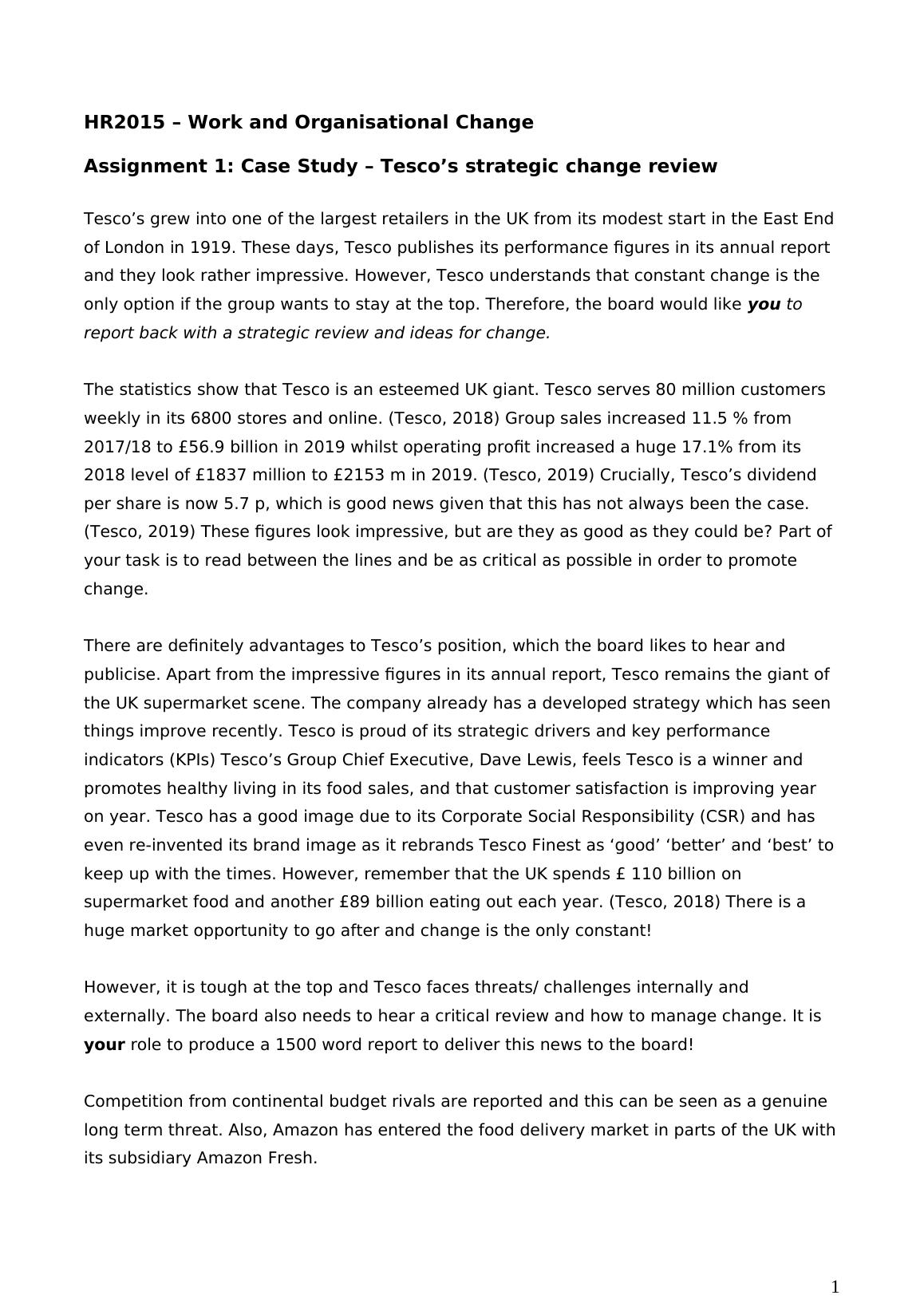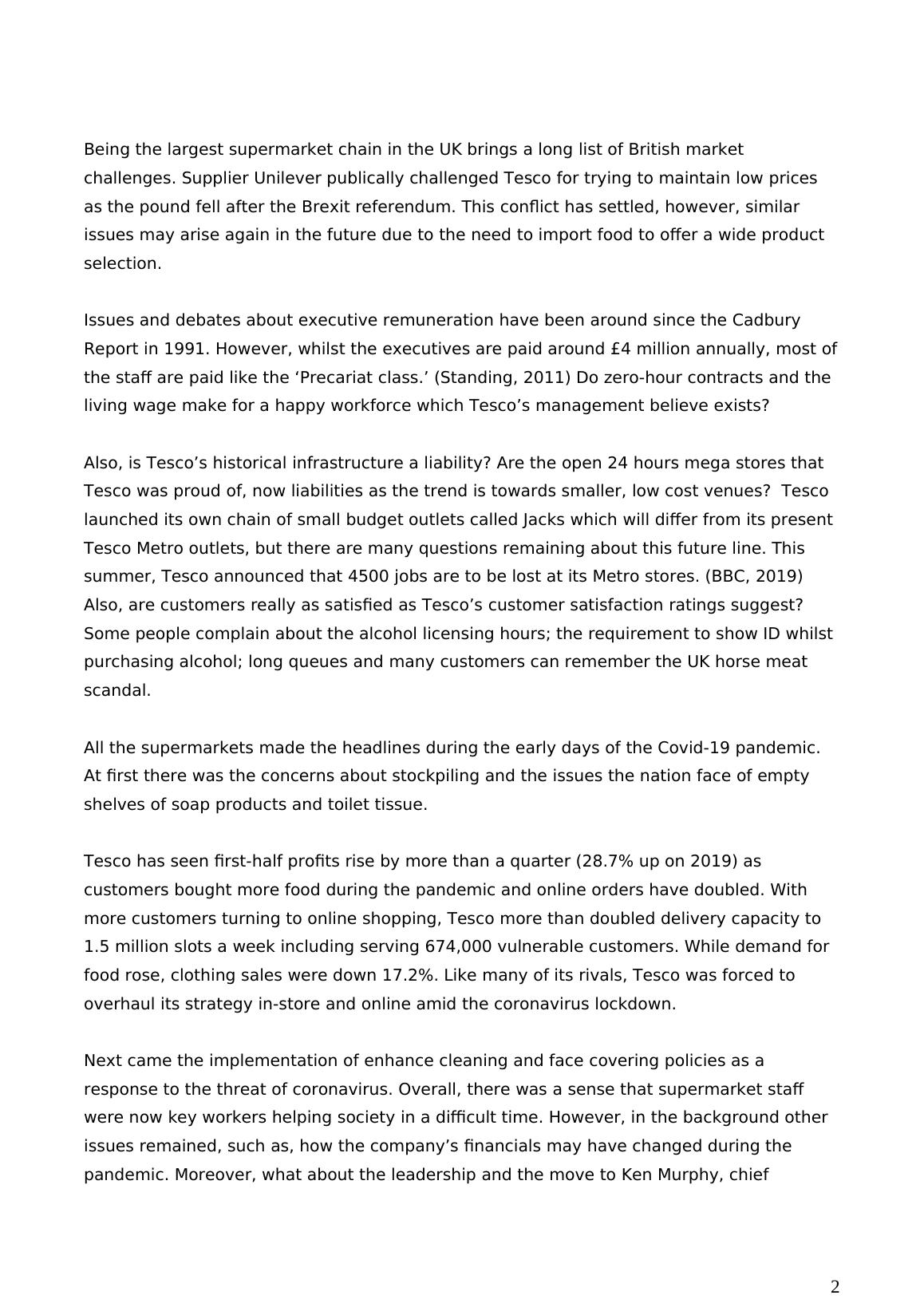HR2015 – Work and Organisational Change
Added on 2021-06-30
4 Pages1345 Words41 Views
HR2015 – Work and Organisational Change Assignment 1: Case Study – Tesco’s strategic change reviewTesco’s grew into one of the largest retailers in the UK from its modest start in the East Endof London in 1919. These days, Tesco publishes its performance figures in its annual report and they look rather impressive. However, Tesco understands that constant change is the only option if the group wants to stay at the top. Therefore, the board would like you to report back with a strategic review and ideas for change.The statistics show that Tesco is an esteemed UK giant. Tesco serves 80 million customers weekly in its 6800 stores and online. (Tesco, 2018) Group sales increased 11.5 % from 2017/18 to £56.9 billion in 2019 whilst operating profit increased a huge 17.1% from its 2018 level of £1837 million to £2153 m in 2019. (Tesco, 2019) Crucially, Tesco’s dividend per share is now 5.7 p, which is good news given that this has not always been the case. (Tesco, 2019) These figures look impressive, but are they as good as they could be?Part of your task is to read between the lines and be as critical as possible in order to promote change. There are definitely advantages to Tesco’s position, which the board likes to hear and publicise. Apart from the impressive figures in its annual report, Tesco remains the giant of the UK supermarket scene. The company already has a developed strategy which has seen things improve recently. Tesco is proud of its strategic drivers and key performance indicators (KPIs) Tesco’s Group Chief Executive, Dave Lewis, feels Tesco is a winner and promotes healthy living in its food sales, and that customer satisfaction is improving year on year. Tesco has a good image due to its Corporate Social Responsibility (CSR) and has even re-invented its brand image as it rebrands Tesco Finest as ‘good’ ‘better’ and ‘best’ tokeep up with the times. However, remember that the UK spends £ 110 billion on supermarket food and another £89 billion eating out each year. (Tesco, 2018) There is a huge market opportunity to go after and change is the only constant!However, it is tough at the top and Tesco faces threats/ challenges internally and externally. The board also needs to hear a critical review and how to manage change. It is your role to produce a 1500 word report to deliver this news to the board! Competition from continental budget rivals are reported and this can be seen as a genuine long term threat. Also, Amazon has entered the food delivery market in parts of the UK withits subsidiary Amazon Fresh. 1

Being the largest supermarket chain in the UK brings a long list of British market challenges. Supplier Unilever publically challenged Tesco for trying to maintain low prices as the pound fell after the Brexit referendum. This conflict has settled, however, similar issues may arise again in the future due to the need to import food to offer a wide product selection.Issues and debates about executive remuneration have been around since the Cadbury Report in 1991. However, whilst the executives are paid around £4 million annually, most ofthe staff are paid like the ‘Precariat class.’ (Standing, 2011) Do zero-hour contracts and the living wage make for a happy workforce which Tesco’s management believe exists? Also, is Tesco’s historical infrastructure a liability? Are the open 24 hours mega stores that Tesco was proud of, now liabilities as the trend is towards smaller, low cost venues? Tesco launched its own chain of small budget outlets called Jacks which will differ from its present Tesco Metro outlets, but there are many questions remaining about this future line. This summer, Tesco announced that 4500 jobs are to be lost at its Metro stores. (BBC, 2019) Also, are customers really as satisfied as Tesco’s customer satisfaction ratings suggest? Some people complain about the alcohol licensing hours; the requirement to show ID whilst purchasing alcohol; long queues and many customers can remember the UK horse meat scandal.All the supermarkets made the headlines during the early days of the Covid-19 pandemic. At first there was the concerns about stockpiling and the issues the nation face of empty shelves of soap products and toilet tissue. Tesco has seen first-half profits rise by more than a quarter (28.7% up on 2019) as customers bought more food during the pandemic and online orders have doubled. With more customers turning to online shopping, Tesco more than doubled delivery capacity to 1.5 million slots a week including serving 674,000 vulnerable customers. While demand for food rose, clothing sales were down 17.2%. Like many of its rivals, Tesco was forced to overhaul its strategy in-store and online amid the coronavirus lockdown.Next came the implementation of enhance cleaning and face covering policies as a response to the threat of coronavirus. Overall, there was a sense that supermarket staff were now key workers helping society in a difficult time. However, in the background other issues remained, such as, how the company’s financials may have changed during the pandemic. Moreover, what about the leadership and the move to Ken Murphy, chief 2

End of preview
Want to access all the pages? Upload your documents or become a member.
Related Documents
Talent Management in Tesco: A Case Studylg...
|11
|2866
|35
Applied Business Research and Analysislg...
|24
|5762
|40
Current Trends in the Supermarket Sectorlg...
|15
|1109
|27
Consultancy Report on Tescolg...
|20
|7051
|481
Report on Structure of the Organisation Woolworth Supermarketlg...
|22
|2967
|37
Repercussions of War on Global Economylg...
|9
|2287
|324
